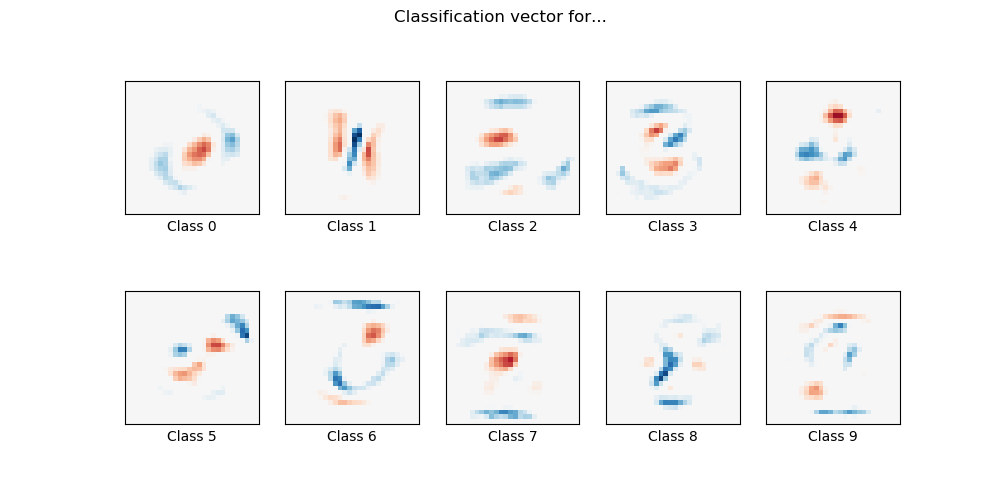MNIST classfification using multinomial logistic + L1¶
Here we fit a multinomial logistic regression with L1 penalty on a subset of the MNIST digits classification task. We use the SAGA algorithm for this purpose: this a solver that is fast when the number of samples is significantly larger than the number of features and is able to finely optimize non-smooth objective functions which is the case with the l1-penalty. Test accuracy reaches > 0.8, while weight vectors remains sparse and therefore more easily interpretable.
Note that this accuracy of this l1-penalized linear model is significantly below what can be reached by an l2-penalized linear model or a non-linear multi-layer perceptron model on this dataset.

Out:
________________________________________________________________________________
[Memory] Calling __main__--home-ubuntu-scikit-learn-examples-linear_model-<string>.fetch_mnist...
fetch_mnist()
_____________________________________________________fetch_mnist - 39.9s, 0.7min
Sparsity with L1 penalty: 80.84%
Test score with L1 penalty: 0.8381
Example run in 43.516 s
import time
import io
import matplotlib.pyplot as plt
import numpy as np
from scipy.io.arff import loadarff
from sklearn.datasets import get_data_home
from sklearn.externals.joblib import Memory
from sklearn.linear_model import LogisticRegression
from sklearn.model_selection import train_test_split
from sklearn.preprocessing import StandardScaler
from sklearn.utils import check_random_state
try:
from urllib.request import urlopen
except ImportError:
# Python 2
from urllib2 import urlopen
print(__doc__)
# Author: Arthur Mensch <arthur.mensch@m4x.org>
# License: BSD 3 clause
# Turn down for faster convergence
t0 = time.time()
train_samples = 5000
memory = Memory(get_data_home())
@memory.cache()
def fetch_mnist():
content = urlopen(
'https://www.openml.org/data/download/52667/mnist_784.arff').read()
data, meta = loadarff(io.StringIO(content.decode('utf8')))
data = data.view([('pixels', '<f8', 784), ('class', '|S1')])
return data['pixels'], data['class']
X, y = fetch_mnist()
random_state = check_random_state(0)
permutation = random_state.permutation(X.shape[0])
X = X[permutation]
y = y[permutation]
X = X.reshape((X.shape[0], -1))
X_train, X_test, y_train, y_test = train_test_split(
X, y, train_size=train_samples, test_size=10000)
scaler = StandardScaler()
X_train = scaler.fit_transform(X_train)
X_test = scaler.transform(X_test)
# Turn up tolerance for faster convergence
clf = LogisticRegression(C=50. / train_samples,
multi_class='multinomial',
penalty='l1', solver='saga', tol=0.1)
clf.fit(X_train, y_train)
sparsity = np.mean(clf.coef_ == 0) * 100
score = clf.score(X_test, y_test)
# print('Best C % .4f' % clf.C_)
print("Sparsity with L1 penalty: %.2f%%" % sparsity)
print("Test score with L1 penalty: %.4f" % score)
coef = clf.coef_.copy()
plt.figure(figsize=(10, 5))
scale = np.abs(coef).max()
for i in range(10):
l1_plot = plt.subplot(2, 5, i + 1)
l1_plot.imshow(coef[i].reshape(28, 28), interpolation='nearest',
cmap=plt.cm.RdBu, vmin=-scale, vmax=scale)
l1_plot.set_xticks(())
l1_plot.set_yticks(())
l1_plot.set_xlabel('Class %i' % i)
plt.suptitle('Classification vector for...')
run_time = time.time() - t0
print('Example run in %.3f s' % run_time)
plt.show()
Total running time of the script: ( 0 minutes 43.520 seconds)

